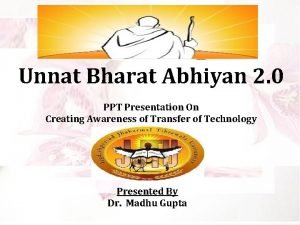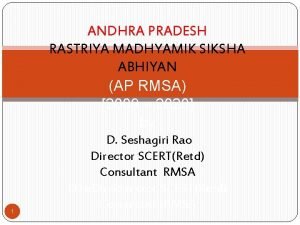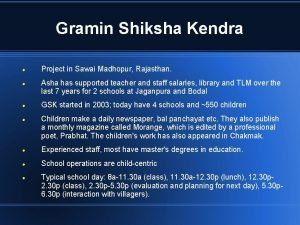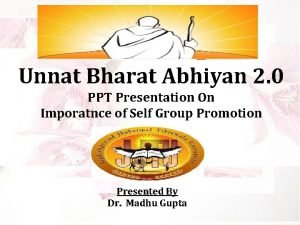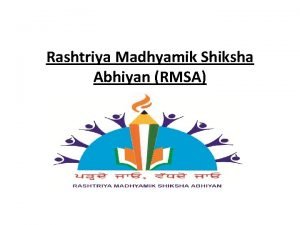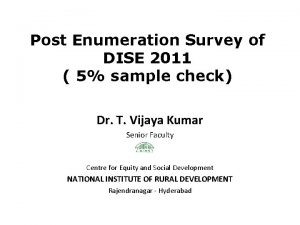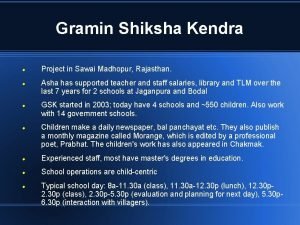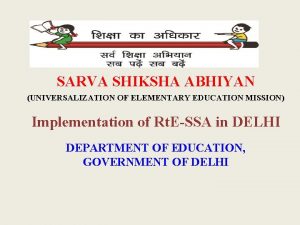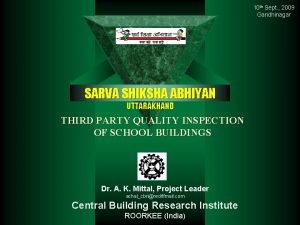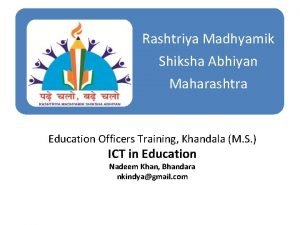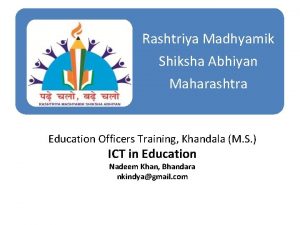A PROGRAMME FOR UNIVERSAL ELEMENTARY EDUCATION SARVA SHIKSHA








- Slides: 8

A PROGRAMME FOR UNIVERSAL ELEMENTARY EDUCATION

SARVA SHIKSHA ABHIYAN • Introduction • Sarva Shiksha Abhiyan (SSA) is a comprehensive and integrated flagship programme of Government of India to attain Universal Elementary Education (UEE), covering the entire country in a mission mode. SSA has been launched in 2001 -2002 in partnership with the State Governments and Local Self Governments. The programme aims to provide useful and relevant, elementary education to all children in the 6 to 14 age group by 2010. It is an initiative to universalize and improve quality of education through decentralized and context specific planning and a process based, time bound implementation strategy. The programme lays emphasis on bridging all gender and social category gaps at elementary education level with time bound objectives. On one hand, SSA is a programme with its own targets, norms and processes and on the other it is an umbrella programme covering other programmes like District Primary Education Programme (DPEP), Lok Jumbish, Operational Blackboard, etc. The gigantic dimensions of the programme and the financial implications call for a meticulous planning and a rigorous appraisal.

India has made long strides in the last 50 years in the field of education. The National Policy on Education 1986 and Programme Of Action 1992 also accorded top priority for achieving the goals of Universal Elementary Education. A number of programmes / schemes were launched during the last four decades for Universalisation of elementary education. Some of these efforts have been in the field of primary education and a few also covering upper primary sector. Due to these interventions, initiated by Government of India and the respective state Governments, there has been considerable progress in providing access, improving retention and the quality improvement in primary education sector. However, much needs to be done for the special focus groups, and the upper primary sector. Quality improvement still remains a major concern, especially for upper primary sector. Sarva Shiksha Abhiyan is an attempt to fill this vacuum and covers all the districts in the country unlike the earlier programmes on elementary education. The programme covers the whole gamut of elementary education sector and is flexible enough to incorporate new interventions like specific interventions for girls, e. g. , NPEGEL, Kasturba Gandhi Programme.

SARVA SHIKSHA ABHIYAN • SSA adopts, “the bottom-up” process of planning, wherein the felt needs of the served communities and educational needs of learners are well taken care of and the plan fits into the broad framework of SSA. In view of the fact that the desired improvement and sustenance of the improved efficiency level can not be achieved without the active involvement of the community in the schooling system, SSA has emphasized the involvement of local people & stakeholders in planning. This also ensures reflection of local specificity, which is essential for achieving the goals of the programme.

Sarva Shiksha Abhiyan is an attempt to provide quality education to all children through active participation of community in a mission mode. The major characteristics of SSA are: • A programme with a clear time frame for universal elementary education. • A response to the demand for quality basic education all over the country. • An opportunity for promoting social justice through basic education. • An effort at effectively involving the Panchayati Raj Institutions, School Management Committees, Village and Urban Slum Level Education Committees, Parents' Teachers' Associations, Mother Teacher Associations, Tribal Autonomous Councils and other grass roots level structures in the management of elementary schools. • An expression of political will for universal elementary education across the country. • A partnership between the Central, State and local government • An opportunity for States to develop their own vision of elementary education.

• Aims and objectives of SSA • • The Sarva Shiksha Abhiyan aims to provide useful and relevant elementary education for all children in the 6 to 14 age group by 2010. There is also another goal to bridge social, regional and gender gaps, with the active participation of the community in the management of schools. Following are the main objectives of SSA: • All children in school, Education Guarantee Centre, Alternate School, 'Back-to-School' camp by 2003. • All children complete five years of primary schooling by 2007. • All children complete eight years of elementary schooling by 2010. • Focus on elementary education of satisfactory quality with emphasis on education for life. • Bridge all gender and social category gaps at primary stage by 2007 and at elementary education level by 2010. • Universal retention by 2010.

• Basic Features of SSA • • • Institutional reforms in states. Sustainable financing in partnership with states (IX Plan 85: 15, X Plan 75: 25, After X plan 50: 50). Community ownership of school based interventions through effective decentralization. Institutional capacity building for improvement in quality. Community based monitoring with full transparency in all aspects of implementation. Community based approach to planning with a habitation as a unit of planning. A mainstreaming gender approach. Focus on the educational participation of children from the SC/ST, religious and linguistic minorities, etc. Thrust on quality and making education relevant. Recognition of critical role of teacher and focus on the human resource development needs of teachers Preparation of District Elementary Education Plans reflecting all governmental and non-governmental investments.

• Major Areas of Interventions in SSA • • Education of out-of-school children (Educational Guarantee Scheme and Alternative & Innovative Education) • Quality Improvement • Special Focus Groups • Research and Evaluation • Management Structure and Institutional Capacity Building • Community Mobilization • Civil Works • Monitoring and MIS • Financial Management and Procurement
